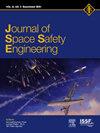Enabling efficient satellite mission design with rule-based collision avoidance
IF 1
Q3 ENGINEERING, AEROSPACE
引用次数: 0
Abstract
The growing number of operational spacecraft in Earth's orbit entails an increasing operational effort for collision avoidance (COLA), particularly regarding the coordination of evasive measures. To reduce the associated workload, COLA operations should already be considered in the early planning phases of space missions. The Mission Analysis Software (MAS) is a web-based application developed within the ESA-funded CASCADE (Collision avoidance, satellite coordination assessment demonstration environment) project by OKAPI:Orbits and TU Darmstadt for this purpose. The software follows a data-driven approach to offer satellite operators, mission designers, service providers, agencies, and authorities two services: conjunction assessment and rule analysis. The conjunction assessment provides an estimation of the number and type of conjunctions to be expected on the targeted orbit and identifies frequently conjuncting parties for the current population of active satellites as well as for conceivable future scenarios. The rule analysis follows a rule-based approach to coordinate COLA between individual operators, allowing users to build custom hierarchical rule sets from pre-defined rule building blocks to achieve a desired split of effort between the conjunction parties. The MAS enables the assessment of the operational consequences for a chosen rule set, empowering users to reach bilateral agreements with identified frequently conjuncting parties to determine the obligation to take evasive measures for future conjunctions. The approach of the MAS allows for the pre-emptive reduction of the expected number of conjunctions enabling operators to optimize orbit parameters within their mission constraints as well as the automatization of COLA coordination during operations. Through this, the MAS optimizes propellant needs, mission time, and required workforce associated with COLA for space missions.
This paper presents the MAS, showcasing the key features and use cases that have been developed closely with stakeholders and the European Space Agency. Furthermore, the data-based simulation approach of the MAS will be explained, covering the data sources and design choices for the conjunction detection and propagation module. The paper also presents the results of a preliminary rule analysis conducted for the population of active satellites in low Earth orbit as of April 2023. As an intermediate result of an on-going research activity involving the authoring entities, a major goal of this paper is to engage with satellite operators, mission designers, service providers, agencies, and authorities in order to tailor the results of the activity to their actual needs.
利用基于规则的防撞技术实现高效的卫星飞行任务设计
由于在地球轨道上运行的航天器数量日益增加,因此需要在避免碰撞方面作出越来越大的努力,特别是在协调规避措施方面。为了减少有关的工作量,应在空间任务的早期规划阶段就考虑到COLA业务。任务分析软件(MAS)是在欧空局资助的CASCADE(避免碰撞,卫星协调评估演示环境)项目中开发的基于网络的应用程序,由OKAPI: orbit和达姆施塔特工业大学为此目的而开发。该软件采用数据驱动的方法,为卫星运营商、任务设计者、服务提供商、机构和当局提供两种服务:联合评估和规则分析。合轨评估提供了对目标轨道上预计的合轨数量和类型的估计,并确定了当前活动卫星数量以及可想象的未来情景的频繁合轨方。规则分析遵循基于规则的方法来协调各个操作符之间的COLA,允许用户从预定义的规则构建块构建自定义的分层规则集,从而在连接方之间实现所需的工作分割。MAS允许对所选规则集的操作后果进行评估,使用户能够与确定的频繁连词方达成双边协议,以确定对未来连词采取规避措施的义务。MAS的方法允许先发制人地减少预期的连接数量,使运营商能够在其任务限制内优化轨道参数,并在操作期间实现COLA协调的自动化。通过这一点,MAS优化推进剂需求、任务时间和与空间任务的COLA相关的所需劳动力。本文介绍了MAS,展示了与利益相关者和欧洲航天局密切合作开发的关键功能和用例。此外,将解释基于数据的MAS仿真方法,包括连接检测和传播模块的数据源和设计选择。本文还介绍了对截至2023年4月的低地球轨道现役卫星数量进行的初步规律分析的结果。作为涉及撰写实体的正在进行的研究活动的中间结果,本文的主要目标是与卫星运营商、任务设计者、服务提供者、机构和当局进行接触,以便根据他们的实际需要定制活动结果。
本文章由计算机程序翻译,如有差异,请以英文原文为准。
求助全文
约1分钟内获得全文
求助全文
来源期刊

Journal of Space Safety Engineering
Engineering-Safety, Risk, Reliability and Quality
CiteScore
2.50
自引率
0.00%
发文量
80
 求助内容:
求助内容: 应助结果提醒方式:
应助结果提醒方式:


